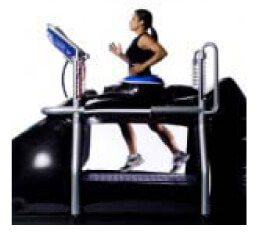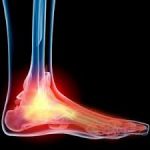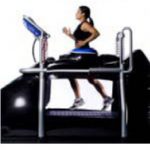Stress fractures are common in runners. Typically stress fractures are seen in newer runners or in runners that increase their weekly mileage too quickly. Recently I saw a patient that experienced a stress fracture in his lower left shin (tibia) after an extended break from running. This particular runner had 10 years of Ultramarathon running under their belt but had taken an extended period of rest from running. Because of his experience he did not think he was susceptible to stress fracture but had increased his mileage too quickly which resulted in excess stress on his bones.
It all started in October when his mother was diagnosed with terminal brain cancer. The doctors told him she had 3 months to live. He moved back to New York to spend those 3 months with her. While he did bring some running clothes he was completely unprepared for the brutal winter that New York was about to experience as well as the emotional strain of watching his mother die. These two variables combined to prohibit him from any significant running for three months. It only takes two weeks of inactivity for bone to begin to deteriorate from lack of impact. Bone requires repetitive stress to maintain its strength. These three months of no running had weakened his bones essentially making him a “new” runner and he should have returned to lower weekly mileage gradually increasing the volume which would have allowed his bones to naturally strengthen to withstand the stress of high mileage running. During the exam I asked him why he had stopped running for 3 months which resulted in the stress fracture. The below is his personal story that he shared with me.
“I was getting ready to go back to New York to stay with my invalid father while my mother would be gone to Italy. She was going with my cousins to visit relatives in Sicily and see some sights. Two days before I was to leave my mother began to experience confusion so my sister brought her to the hospital. It all happened so quickly. The situation went from not knowing what was wrong to having a brain scan and seeing the tumor to my mother requiring emergency brain surgery.”
“When I arrived in New York two days later I went straight to the Intensive Care Unit. To my surprise my mother was awake and alert! Those first few days were spent going back and forth from my house to the hospital to spend as much time as possible with her. One day when the doctor came to take the bandages from her head he spoke to me privately in the hall. He explained how she had the most aggressive brain tumor there was and that she probably had three months to live at best. During the surgery he had attempted to remove some of the tumor, the portion that was putting the most pressure on her brain. Although mildly successful it left my mother paralyzed on her left side. This resulted in her having to go to rehabilitation for 3 weeks before she could come home. I decided that day that I would not be returning to my home in San Diego and would stay in New York for the rehabilitation process to ensure my mother received the best treatment and also act as her physical and emotional coach. During these first three weeks my running went from 50-60 miles a week to somewhere around 10 miles a week.”
“Although I was training for two fifty mile races in the spring and intellectually knew I had better find a way to start running more mileage I simply could not get myself to do it. There were a couple of factors that caused me not to run. I was running back and forth to the rehabilitation center twice a day. Once to help the physical therapist get my mom walking again and the second time to have dinner with my mom. In between these visits I was at home helping to get things organized and also cooking for my father. The weather began to take a turn for the worse and we experienced our first snowfall before Thanksgiving. One of the other variables I had “forgotten” about New York in the fall was the wind! I’ve lived in San Diego for 15 years and have typically travelled back to New York only during the summer. The running conditions in the winter are perfectly miserable. Mostly cold with temperatures sometimes below freezing, snow, freezing rain and gusts of wind that bend trees and freeze your face while standing you straight up as you run into it! I would do my best to time my runs in the mid-afternoon when the sun was at its highest but was only successful with this strategy once or twice a week. I tried to run one morning as I normally do in San Diego. Three miles in I could not feel my hands or face and turned back to the house. I often wondered how long distance runners in New York are able to manage getting in their miles in these wretched conditions. As the weeks wore on my mileage continued to drop and the situation with my mother and the weather became more severe.”
“My mother was released from rehabilitation around Thanksgiving and I brought her home. My days became filled with visits to the oncologist and hosting visiting relatives and friends that would come over daily to see my mother. While I treasured this special time with my mother I knew it was also having a profoundly negative impact on my training and conditioning. I did my best to get in a run here and there. I hated running in New York. Besides the horrible conditions there were no trails to run on. In San Diego I live near three canyons that I can run 20 miles at a clip without ever seeing a car, traffic light or even another person. This makes running enjoyable to me. In New York I found myself struggling to run even 5 miles at a time on the same boring roads! The monotony of running these same roads through torrential downpours and snow rutted sidewalks was not fun at all. I noticed myself starting to make excuses not to run. I would sometimes have to talk myself into an easy 3 miler! I did not realize it but all this time my hard earned and well conditioned bones and muscles were suffering and deteriorating from neglect.”
“My mother passed in late January. The day of her funeral was no different than the rest of that miserable New York winter. It started with snow the night before and then during her funeral procession turned to freezing rain and then back to snow again. My wife and I were the last plane allowed to leave JFK that day. When I got back to San Diego and stepped off the plane the warmth was the first thing I noticed. It’s funny how such a simple thing as the sun can make you feel so good inside. I began to “coach myself up” mentally for all of the running that was about to come. My first 50 mile race, The Lost Boys 50 was on April 25. I had about 3 months to get ready and get myself back into decent running shape. I went from practically 3 months of no running to running 30 miles a week. My legs felt like they had roots in the ground. I had evidently also gained about 15 pounds during my time in New York and I could tell by the way I was huffing and puffing that the weight would need to come off. During the second month of training I was back to about 50 miles a week and down approximately 5 lbs. My breathing was beginning to get back to normal and I was feeling pretty good about how I would do in the 50. That’s when I began to feel the sensation in my lower left shin. At first it was just a hint of discomfort. It was easy for me to attribute it to the quick increase in my mileage and shrug it off as my body just adapting to all the pounding again. I knew I also had a back down week coming and convinced myself that the week of rest would take care of the issue. After 6 days of no running I went out with my friend for one of our favorite 10 mile runs. Right near the end of it the familiar sensation returned to my leg. I would not really describe it as pain but my gut told me that something was wrong. You see, I use to treat injured runners for a living. For 15 years I had been diagnosing and treating stress fractures in runners. I know all too well the early warning signs that most runners ignore. I am also intimately familiar with the way runners convince themselves that it does not really hurt when they run…….but they can barely walk the next day. They do this because not only do they love running but usually they are training for an event and if they concede that they have a fracture they would have to then stop training for 4-6 weeks. There are also other psychological variables like fear of gaining weight that cause runners to continue to run on their injury even though they realize the problem is worsening.”
“The next day we went for another 10 mile run in one of our favorite canyons. The “sensation” in my leg, when I was honest with myself, was definitely becoming less of a sensation and more of a noticeable pain. When I returned home I examined my lower tibia by pressing on the painful area. The bone was noticeably uncomfortable and slightly painful to the touch. I could not believe it! How could I, a ten year ultrarunning veteran get a stress fracture! I began self talking and trying to convince myself that it was probably just bone inflammation and not a stress fracture. There are different stages of bone stress injuries. It can start with bone inflammation which is referred to as Periostitis. It can then progress to bone marrow edema. Bone marrow edema is the process where the cells inside your bone swell due to repetitive impact. The internal swelling results in a slightly painful sensation that usually goes away when you stop running. The third stage of bone injury is the dreaded stress fracture. If the bone marrow continues to swell and is left unchecked the pressure increases inside the bone cavity and can cause the bone to crack from the inside out. At this stage it begins to hurt while you run and results in limping and pain after running. I knew I was at this stage but did not want to accept it.”
“Luckily for me I know you (Dr. Allen) and that San Diego Running Institute has state of the art technology. Years ago you purchased an Alter Gravity Treadmill and have used it successfully to rehabilitate runners with fractures. Not only had their stress fractures healed about 2 weeks quicker than normal but they are able to run while their fractures heal! The Anti Gravity Treadmill or AlterG as it is known is an ingenious invention that allows for me to run with my lower body inside of an air chamber. While running the computer pumps air into the chamber allowing me to run at a decreased body weight. When running at a decreased body weight there is less impact on my bones. You simply adjusted my body weight while I ran until it is low enough that the impact does not irritate the stress fracture! Day by day, week by week as my bone began to heal you adjusted my body weight closer to normal. So as I was healing I was able to run and train for my 50 Miler! Here is the best part, because you are running with some impact you are actually stimulating your bone to grow and repair more quickly!”
“I did my first session on the AlterG two weeks ago. I was able to run for 2 hours at 65% of my body weight. I began running every other day, 2 hours at a time gradually adding my body weight back during my running sessions. Within 2 weeks I was successfully running at 75% of my body weight and noticing that the bone was not painful to the touch anymore! As the bone improved I started testing it by doing the last 5 minutes of my run at 100% of my body weight. When that was not painful I attempted short runs outside of 1-2 miles without pain. When you come back from a significant running injury you have to be careful not to aggravate it and set yourself back. The AlterG is the perfect rehabilitation tool in that it allows you to immediately adjust your body weight at the first sign up pain. It allows you to run part of your run at full body weight and part of it at a decreased weight which in turn reduces your risk of aggravating the injury. It is unfortunate that the general running population is not aware of this important rehabilitation machine. Because of the AlterG I am now going to be able to not only run my 50 miler but I should be able to run it well because I have been able to put in 50 miles a week right up to the race! In the past this would not have been remotely possible. A stress fracture would have sidelined me and relegated me to swimming, biking and an elliptical. While these are all excellent forms of cardio they are not running. Trying to run a 50 mile race after not running for 6 weeks would be dismal experience at best.”
If you have injury that you think might be bone related ask yourself the following questions and be honest with yourself.
- Is the pain constant or get worse when I run and lessen when I stop?
- Do I limp while running or after running?
- Does the pain appear to be worsening?
If you answered yes to any of these questions consider that you may have either bone marrow edema or a stress fracture. Then consider finding a sports medicine clinic with an AlterG in your area. Call and ask if you can do a free demo. Hopefully you can use it to keep running while you are injured and still complete your goals. If you have questions about your injury or the AlterG feel free to email info@sdri.net or to schedule an appointment call 858-268-8525
The medical information on this site is provided as an information resource only, and is not to be used or relied on for any diagnostic or treatment purposes. This information is not intended to be patient education, does not create any patient-physician relationship, and should not be used as a substitute for professional diagnosis and treatment.




Leave A Comment